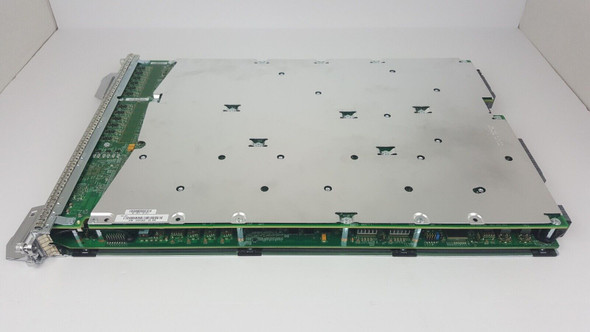Cisco
Cisco A9K-4HG-FLEX-SE ASR 9000 400GE Service Edge Combo Line Card - 5th Gen
- MPN:
- A9K-4HG-FLEX-SE
- Condition:
- Refurbished
- Shipping:
- Free Shipping
Description
Cisco A9K-4HG-FLEX-S
Overview
The Cisco A9K-4HG-FLEX-SE is a line card designed for the Cisco ASR 9000 Series Aggregation Services Routers, offering flexible high-density 40/100 Gigabit Ethernet connectivity. It is optimized for service provider edge and data center networks requiring high throughput, flexibility, and scalability in Ethernet services. This line card is typically used for applications such as large-scale cloud deployments, video streaming, and next-generation service provider infrastructures.
The Cisco A9K-4HG-FLEX-SE line card is a flexible, high-density 40/100GbE line card designed for the Cisco ASR 9000 Series routers. With 4 QSFP+ or QSFP28 ports, it supports high-speed Ethernet connectivity, including breakout options for 10GbE and 25GbE. It provides advanced Layer 2/3 functionality, MPLS support, and high availability features, making it ideal for service provider networks and large data centers.
Specifications
- Model: Cisco A9K-4HG-FLEX-SE
- Series: Cisco ASR 9000 Series Aggregation Services Routers
- Type: High-performance flexible 40/100 Gigabit Ethernet line card
- Role: Service provider edge, aggregation, and core networking
- Form Factor: Modular line card for Cisco ASR 9000 Series routers
- 2. Interfaces and Ports
- 4 x 40/100 Gigabit Ethernet ports:
- These ports can operate as either 40GbE or 100GbE, providing flexible connectivity options.
- Each port supports QSFP+ (40GbE) and QSFP28 (100GbE) transceivers, allowing for multiple configurations.
- Breakout Support: The ports support breakout configurations for:
- 4x10GbE (in 40GbE mode)
- 4x25GbE (in 100GbE mode)
- Allows for flexible deployments based on network requirements.
- 3. Performance
- Total Throughput: Supports up to 400 Gbps of aggregate throughput.
- Forwarding Rate: Line-rate forwarding for all supported interface speeds (40GbE and 100GbE), ensuring wire-speed forwarding across all ports.
- Low Latency: Optimized for low-latency performance, making it suitable for high-performance applications like financial services or high-frequency trading environments.
- 4. Layer 2 and Layer 3 Features
- Layer 2 Switching:
- VLAN Support: IEEE 802.1Q VLAN tagging for traffic segmentation.
- Spanning Tree Protocol (STP, RSTP, MSTP): Supports standard Spanning Tree protocols for network loop prevention.
- Link Aggregation: Supports IEEE 802.3ad Link Aggregation Control Protocol (LACP) for bundling multiple physical links into a single logical link.
- Jumbo Frames: Supports jumbo frames with an MTU of up to 9,216 bytes for efficient large data transfers.
- Layer 3 Routing:
- Full support for dynamic routing protocols, including:
- OSPF, BGP, IS-IS, and RIP.
- IPv4 and IPv6 routing support.
- Multicast Routing: Includes PIM-SM, PIM-DM, and PIM-SSM for efficient delivery of multicast traffic.
- Virtual Routing and Forwarding (VRF): VRF-lite for network segmentation and support for multiple routing instances.
- MPLS Support: Full MPLS (Multiprotocol Label Switching) capabilities, including MPLS VPNs, MPLS TE (Traffic Engineering), and L2/L3 VPNs.
- 5. Quality of Service (QoS)
- Traffic Prioritization: Supports advanced QoS features for traffic classification, marking, policing, and shaping.
- Hardware Queuing: Provides eight hardware queues per port for granular traffic prioritization and scheduling.
- Congestion Management: Features include WRED (Weighted Random Early Detection) and ECN (Explicit Congestion Notification) for congestion avoidance and management.
- 6. Security Features
- Access Control Lists (ACLs): Supports both Layer 2 and Layer 3 ACLs for traffic filtering and security.
- Control Plane Policing (CoPP): Protects the control plane by limiting the rate of control traffic to prevent denial-of-service attacks.
- MAC Security: Provides support for MACsec (IEEE 802.1AE) for encrypting traffic at Layer 2 between switches or routers to prevent eavesdropping or data tampering.
- 7. High Availability and Redundancy
- Redundancy: Designed for high availability, supporting Cisco’s In-Service Software Upgrade (ISSU), which allows for software upgrades without interrupting network operations.
- Failover: Supports Stateful Switchover (SSO) for hitless failover between redundant route processors in the ASR 9000 chassis.
- VSS/Stacking: Integrated with Virtual Switching System (VSS) for increased reliability and high availability across the network.
- 8. Power and Cooling
- Power Consumption: Typical power consumption is approximately 300W (varies depending on configuration and traffic load).
- Cooling: The card relies on the chassis cooling system of the ASR 9000 Series, with airflow designed for efficient heat dissipation in dense network environments.
- 9. Chassis Compatibility
- Cisco ASR 9000 Series:
- Compatible with ASR 9006, ASR 9010, ASR 9904, ASR 9912, and ASR 9922 chassis models.
- Requires a compatible route processor and fabric card within the chassis for full functionality.
- 10. Software Features
- Cisco IOS XR Operating System: Runs on Cisco's IOS XR, a carrier-class operating system designed for high availability, scalability, and service provider-grade networking.
- Automation and Telemetry: Supports modern network automation tools (Ansible, NETCONF, RESTCONF) and streaming telemetry for real-time network analytics.
- Service Flexibility: Provides support for Cisco's flexible consumption model for various network services, which can be enabled based on licensing.
- 11. Environmental Specifications
- Operating Temperature: 32°F to 104°F (0°C to 40°C)
- Storage Temperature: -40°F to 158°F (-40°C to 70°C)
- Operating Humidity: 5% to 85% (non-condensing)
- 12. Certifications and Compliance
- RoHS: Fully compliant with the Restriction of Hazardous Substances (RoHS) directive.
- Safety Certifications: UL, CSA, EN, IEC standards for safety compliance.
- EMI/EMC Compliance: Meets FCC, CE, and other global standards for electromagnetic interference and compatibility.
- 13. Use Cases
- Service Provider Edge: Ideal for service provider edge networks requiring high-speed Ethernet connectivity and advanced routing capabilities.
- Data Center Interconnect (DCI): Provides high-capacity interconnects between data centers with robust Layer 2 and Layer 3 services.
- High-Performance Aggregation: Suitable for aggregation points in large service provider and enterprise networks.
- Cloud Networking: Used in large-scale cloud environments requiring high throughput and flexible port configuration.












